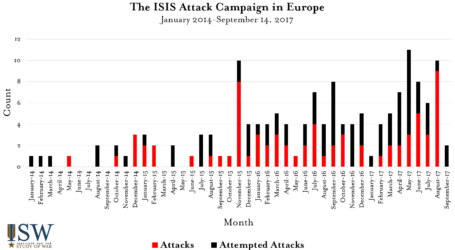Espansione dell’ Isis in nord Africa e nella penisola arabica
The Arab Spring and its aftermath created opportunities for jihadists to organize and mobilize on a wider scale than previously possible. Jihadists quickly organized in the aftermath of the Arab Spring of 2011, creating the foundations for ISIS’ mobilization of fighters enmasse.
- Libya and Tunisia, where governments fell during the Arab Spring, produced more fighters per capita than Morocco and Algeria, where governments survived local protests. Eighteen of the top 20 provinces ISIS fighters came from in North Africa were in Libya or Tunisia.
- In Tunisia, ISIS built upon local Salafi-Jihadist recruiting networks like Ansar al-Sharia, which took advantage of the post-Ben Ali environment of political openness to openly promote jihad. Tunisian ISIS fighters often listed Ansar al-Sharia’s leaders as having recommended them to join ISIS.
- In Libya, jihadists were able to operate and recruit openly amid the patchwork of militias that emerged following Ghaddafi’s fall. More than half of Libyan ISIS fighters reported having prior experience in jihadist conflicts, almost entirely in Libya.
Most provinces in North Africa with high rates of ISIS fighter recruitment were economically and politically marginalized. They had high rates of underemployment, lack of political representation and poor access to social services compared to their national contexts. The geographic origins of ISIS recruits from North Africa suggest the group took advantage of long-standing frustrations in marginalized communities to mobilize fighters.
- Derna (Libya) and Kebili (Tunisia) were the two provinces in North Africa with the highest rates of ISIS fighters. Nearly three-quarters of fighters from these provinces reported little or no employment.
- Provinces in North Africa where fighters reported the least reliable employment had the highest rates of ISIS recruitment. There is a negative correlation between the quality of employment and the number of ISIS recruits in the top 20 per capita fighter-producing provinces in North Africa.
- More than eight in 10 of ISIS’ foreign fighters from Libya came from the country’s eastern region. Eastern Libya suffered from higher underemployment than Libya’s west, was excluded from patronage networks under Muammar Ghaddafi and suffered from poor service provision. Fighters from eastern Libya reported worse employment situations than fighters from western Libya. The issue of marginalization is particularly acute in Derna, which had a higher rate of ISIS foreign fighters and whose fighters reported lower economic and educational attainment levels than anywhere else in eastern Libya, including Benghazi.
- In Tunisia, fighters came at the highest rates from the capital, Tunis, and its suburbs or the southern border areas. Tunisia’s wealthy eastern coast produced fighters at a lower rate than other regions of Tunisia.
- Around the capital, fighters came disproportionately from economically struggling neighborhoods. The lower-class neighborhood of Ettadhamen, for example, produced fighters at a rate three times that of the rest of the Tunis region.
- More than half of all fighters from Morocco came from its poorer, less integrated northern provinces, despite this region accounting for approximately one-quarter of the country’s population.
In the Arabian Peninsula
ISIS mobilized different types of recruits from the Arabian Peninsula than those who joined jihadist conflicts in the past. Although there have long been Salafi-Jihadists from the Arabian Peninsula, those who joined ISIS were generally new to jihadist conflicts.
- In Saudi Arabia, ISIS fighters were disproportionately from the Wahhabi heartland of the Nejd, whereas previous sources of jihadists from Saudi Arabia were the cities of Mecca, Medina and Jeddah. People in the region of Nejd are more interested in the social ordering of Islamic societies, which means it is possible that ISIS’ propaganda of building an Islamic State resonated more strongly than al-Qaeda’s notions of geopolitical conflict. Social networks and mobilizations during the 2011 Arab Spring may have also played a role in the disproportionate number of fighters from the Nejd.
- In Bahrain, Sunni populations were militarized to help end the predominantly Shi’a Arab Spring demonstrations in 2011. Bahrainis joined ISIS at a higher rate than for previous jihadi conflicts in part as a result of this militarization.
- In Yemen, there were far fewer foreign fighters in the ISIS sample as compared to the number of Yemenis recorded fighting in Iraq or Afghanistan. This is likely for two reasons: first, that the ongoing civil war in Yemen kept would-be ISIS fighters at home; second, that al-Qaeda is more established in Yemen than ISIS. This means that if Yemenis were traveling to fight in Syria, they were more likely to join the al-Qaeda affiliate, Hay’at Tahrir al-Sham, than ISIS.
Regions in the Arabian Peninsula with disproportionate numbers of ISIS recruits had larger proportions of young people (ages 15-24) than normal for their respective countries. Youthfulness was the most substantial positive correlation that this study found among hot spots of recruitment in the Arabian Peninsula, which also compared economic well-being and historical rates of jihadist mobilization.
- Provinces in the Arabian Peninsula with high rates of ISIS fighters were traditionally close to their country’s ruling elites. Though individual fighters from these regions might have been worse off in comparison to the general population, as a whole they did not come from marginalized communities.
- The proximity of regions in the Arabian Peninsula with high rates of ISIS foreign fighters to political elites may partially explain the reluctance of local governments to prosecute ISIS recruits during the first few years of its existence. Saudi Arabia, Bahrain and Kuwait did not crack down on ISIS recruitment in their own territories until 2015, when high-profile attacks threatened their domestic security.
- The root causes that led to ISIS’ rise remain unaddressed in the Arabian Peninsula, which raises the specter of a renewed foreign fighter mass mobilization in the future.
Economic growth and political inclusion should be security priorities for North Africa. While it will be important to address ISIS’ ideological message in North Africa, ISIS’ mobilization drew upon long-standing conditions of marginalization that are likely to generate new mobilizations in the absence of efforts to expand economic and political inclusion in the region.
Addressing the ideological roots of Salafi-Jihadism should be a security priority in the Arabian Peninsula. ISIS’ propaganda resonated among a new cohort of jihadists who utilized elite-level connections to facilitate the recruitment of fighters on a large scale. That these fighters were new to jihad and left the region to fight meant that they were not deemed a threat by the security infrastructure in the Arabian Peninsula. New policy approaches to the region must encourage governments in the Arabian Peninsula to address the ideological roots sanctioning violent religious radicalism and view conflicts that mobilize domestic militants to fight abroad as a serious security threat.





